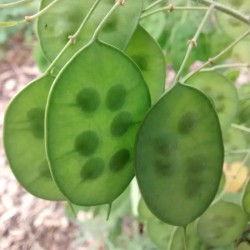Honesty Silver Pennies Seeds (Lunaria annua)
Price for Package of 10 seeds.
Lunaria annua is an old fashioned dual purpose plant, grown partly for its fragrant bright flowers in spring and summer, but also for its unique seed-heads, oval and translucent, gleaming with an eerie silver light and coveted by dried-flower arrangers. It is properly grown as a biennial, and makes large, well-branched plants in its second year. However, smaller plants can be grown as hardy annuals from an early sowing, with a smaller flower display, but very good compact seed-heads
Before the days of sophisticated dried flowers Honesty was particularly popular at Christmas and New Year and, after it had been arranged, would often stay in its vase for months. If it was home-grown it would be cut during a dry spell in September or October, then hung upside down in a dry place until needed. Nowadays most of us would prefer to leave the plants to decorate the garden. There is keener interest in the winter garden and the seed pods of honesty can look wonderful in an otherwise bleak garden.
Honesty blooms in rich, purples, pinks and starry bi-coloured combinations which are almost fluorescent at sunset. It is a vital nectar plant and therefore popular with bees and butterflies, very easy to grow, normally self-seeding itself in sunny or shady positions
Over a long season it produces masses of silvery pods. When dried, the green outer covering peels off to reveal the silvery translucent "silver pennies” or “dollars”.
Sowing: Sow direct in spring to late summer
Seeds can be sown in situ otherwise they can be simply sprinkled on loam-based seed compost, covered with grit and kept in a warm, light place.
Sowing Direct:
Sow thinly outdoors directly where they are to flower, in drills 3mm (1/8in) deep. 30cm (12in) apart. Keep the soil damp until germination takes place and if the seedlings become crowded, thin out to 15cm (6in) apart. Cover the seed lightly and water well.
Sowing Indoors:
Sow the large seeds one to a module compartment or in separate pots – where they can develop individually and be planted out without root disturbance. Use a loam-based seed compost, cover with grit and kept in a warm, light place. Honesty develops thick storage roots, almost like tubers, and, in common with other brassicas, has deep tap roots. Keeping them in pots for any length of time prevents the roots developing properly and, if plants are not put out promptly, they will dwindle. Prepare the planting hole with plenty of good home-made compost or leaf-mould. Plant out when all frosts have gone.
Cultivation:
Lunaria annua needs no pampering; it will cope in most situations and seems happiest growing among other plants. Grow in fertile, moist but well-drained soil. It prefers partial shade but will tolerate full sun. In common with most brassicas it prefers lime and resents peat or very acidic conditions. Avoid overfeeding and do not use manure.
Dried Flowers:
The key to getting good “silver pennies” is to make sure that the seed pods are perfectly dry. Cut the stems bearing seed pods and hang in bunches upside down in a cool airy room to dry. Once dry, gently remove the outer seed casing before using them for floral decoration.
Collecting Seed
Spread out the flower heads on a piece of drawing paper when they are dry and crisp. Each disc is composed of twin circular plates locked together and enclosing three large flat seeds. These are also disc-shaped At the top of each case is a tiny protuberance that you pull like a ring-pull on a can to peel off one layer. The three seeds stick to this thin skin, leaving the backing-sheet clean and translucently silver, still attached to the stalk.
Plant Uses:
Cottage/Informal Garden, Flower Arranging, Flowers Borders and Beds. Butterfly and Wildflower Gardens. Origin: although not a true native of the British Isles. Lunaria annua is originally of European origin, Lunaria annua is common in gardens and it is often found naturalised as a garden escapee.
Nomenclature The genus name Lunaria is derived from the Latin "lun (a)" meaning "moon" pertaining to the big round fruits of the plant. The species name annua is from the Latin "annu" meaning "year". The plant is typically biennial, however. A member of the Brassicaceae or Cruciferae, also known as the crucifers, the mustard family or cabbage family is a family of flowering plants. Cruciferae is an older name, meaning "cross-bearing", because the four petals of their flowers are reminiscent of a cross.
Flowers: Lilac / Pink in April to July
Height: 60-90cm (24-36)
Spacing: 38-45cm (15-18in)
Position: Full Sun to Partial Shade





